Street Fighter III was the long-awaited hit from 1997. Thanks in part to the dazzling animation featured on Elena and her contemporaries. Unfortunately advances in 3D technology were putting the squeeze on Capcom. Namco had fired a shot across the bow of their rival with a new character named Eddy Gordo in the game Tekken 3. The animations for Eddy were created by motion capture. Mestre (master)
Marcelo "Caverinha" Pereira lent his talents to the game. The end result was a character that had genuine personality and moved unlike anybody else in fighting game history. Eddy became an overnight sensation. Arcade players were eager to find what combos worked best for the character and even what hidden moves Namco had included. Unlike every other martial art featured in the game Eddy seemed capable of flowing from move to move without having to reset to a standing position. This distinction set Tekken apart from even Street Fighter.
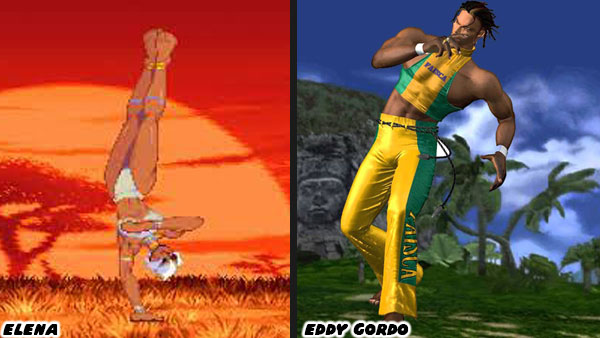
For example Elena reset to her standing animation after every attack but Eddy could make an attack into a handstand and still be able to turn and move while upside down. Gordo was such as easy character to control and play as that he became appealing to many novices. They could almost blindly mash the four control buttons and put together a fluid combo string. The term "dial a combo" used by fighting game fans to describe a simple control interface was coined with Eddy in mind. Beginning players looked like pros while Eddy spun, jumped and kicked in all three dimensions. The ease of use upset many players. They felt as if the balance between the various fighting styles had been upset. At no other time had this game or any other inserted a character whose attacks came in rapid succession through simple button sequences. Even Elena required timing and practice just like the other characters in SFIII.
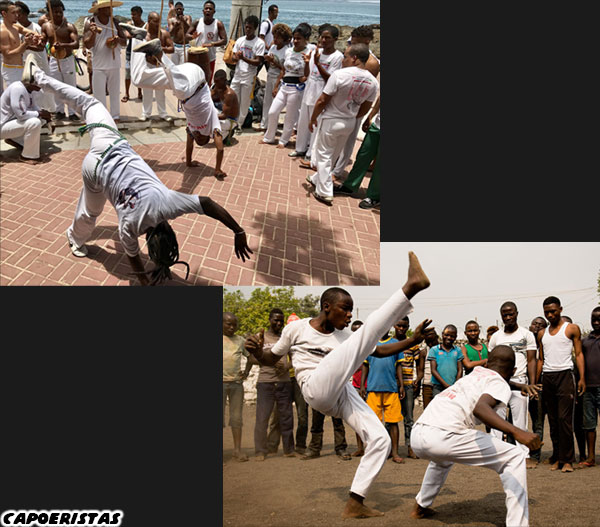
The afro-sporting, bellbottom wearing Tiger Jackson was the alternate character created from Eddy's motion capture data and moves. Jackson never developed the following that Gordo had. He looked like a joke character and was treated as such by most Western gamers. Despite having the same moves as Eddy he was less frequently played in arcades, even by most in the black community. Eddy and Elena introduced something original to the genre. Most fighting games featured either a white person from the US or a Japanese person in the leading roles. It was almost assumed by the developers that people from other countries could never play an important role in the game. Elena and Eddy dispelled that myth. Capcom and Namco won over minority and non-minority players by treating them all with respect. These two were not basketball players, boxers or break dancers. The developers did not rely on trope for the new minority characters but instead grounded them in a real system. This exposed people around the world to capoeira and made two new stars in the process.
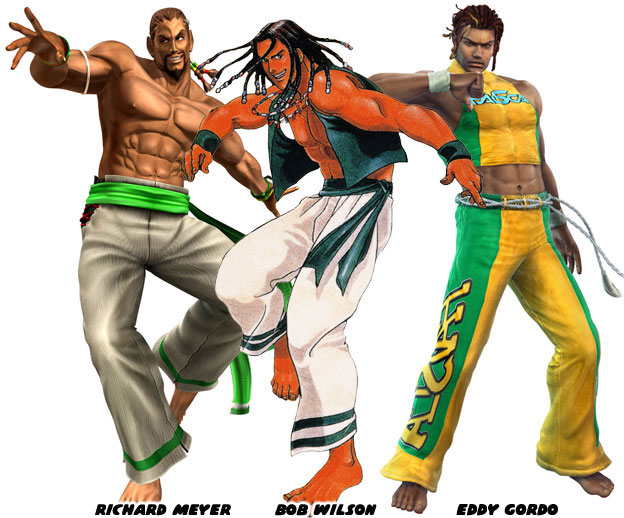
It turned out that neither Eddie Gordo or Elena were even the first capoeiristas featured in a game. They weren't even the second ones for that matter. At the dawn of the genre, around 1989, there was a villain named "Slippery" Sam Santana, the 38-year-old character was featured in an SNK fighting game called Street Smart. The characters did not have names in the original arcade release. It would only be revealed once the game was translated to the Sega Mega Drive a year later. The tanned brawler with the long pants and sunglasses was simply known as the Stage 2 boss. His use of tumbling attacks as well as the ability to flip and spin away from opponents had a very distinct capoeira appearance. The designers at SNK were very fond of the unique fighting arts from around the world. They would continue to learn from the fighting community and refine the characters until they were ready for the genre.
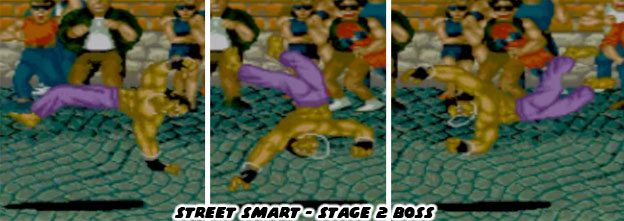
The first capoeira character worth highlighting in an arcade fighting game was Richard Meyer. He appeared in Fatal Fury, a 1991 title that was also published by SNK. The game was designed by Takashi Nishiyama and Hiroshi Matsumoto. They were planners on the original Street Fighter for Capcom but then moved to the rival studio shortly after it was released. Some of the Japanese developers had been aware of capoeira and had experimented with the form in Street Smart. It didn't really take off prior to 1991 due to the limitations of the hardware and software. Nishiyama and Matsumoto took a chance with the "exotic" style in Fatal Fury. Meyer's kick based moves were revolutionary. He would perform handstand kicks and tumble through the air with wide sweeping motions. He could even hold onto the rafters on his stage and kick at the player. Despite the limitations of the game engine he had a sort of shuffle to indicate the
ginga or dancing stance of the art. The immigrant to the fictional Southtown carried with him the music and atmosphere of Brazil. His club, the Pao Pao Café, became well recognized in the series.
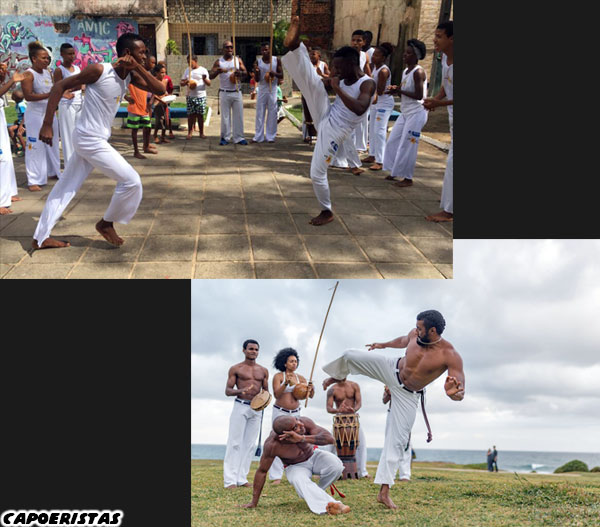
In game canon Meyer retired from fighting to run his club. Bob Wilson, introduced in Real Bout Fatal Fury 3, became the second Capoeira practitioner in fighting game history. Although when the game was originally translated in the USA it was called "Cooperia." The sleeper from 1995 actually influenced SNK canon. As a bouncer Wilson accidentally burned down the Pao Pao Café 2. It would be rebuilt and multiple sister clubs would be featured in other SNK games including the King of Fighters. By 1997 gamers had become somewhat acquainted with the art form. It wasn't until the brilliant animations from Capcom and the motion capture sessions from Namco that players really took notice. Capoeira had arrived and would become part of gaming landscape forever.
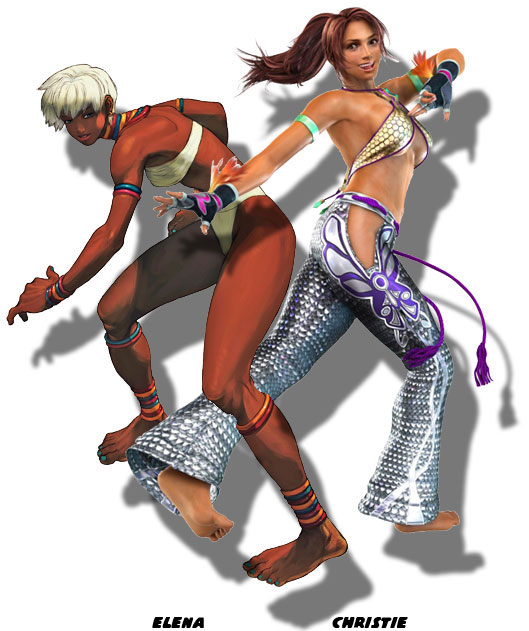
The next Capoeira star would be Christie Monteiro. She was the daughter of Eddy Gordo's teacher and one of the new faces in Tekken 4, a game from 2001. The character was created using the same motion capture data as Eddy and Tiger Jackson along with some new moves thrown in. The graphics had been improved considerably on the new Namco System 246 hardware. Despite the bump in graphics, lighting, effects and level design, Namco was keenly aware that sex was a major selling point for many characters. Eddy would appear down the road as an secret character but Christie was designed to get the attention of players. This skin show was obvious pandering to the mostly male fans of the genre. The objectification of women in fighting games is a topic for another day. For Elena and Christie the looks got the attention of the players but the Capoeira moves were the icing on the cake. Not that many gamers complained about the sexy designs as the Tekken series stood on its own merit. It was a well designed and well balanced game. It had more things going for it than Killer Instinct and thus saw far more sequels. Tekken, along with Sega's Virtua Fighter, would continue to be the standard by which all other 3D fighting games would be measured.
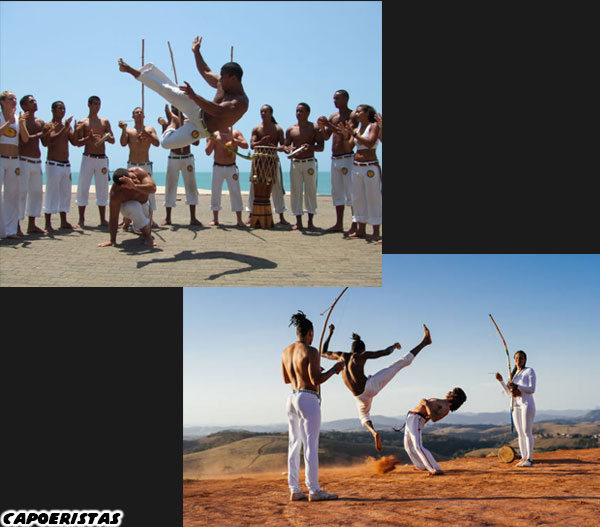
Even Evoga, the developers of the Rage of Dragons, were not immune to the appeal of capoeira. They had created the insipid Mr. Jones but followed up with some more original ideas. Brazilian Pupa Salgueiro and Mexican Pepe Rodriguez were a tag team pair that added color to the lineup. Pepe had a fictional fighting form given to him while Pupa had a variation of capoeira. Pupa made for an interesting choice because she was young and undersized compared to the other characters in the game. There was another young girl in the game named Alice Carroll but she had awe-inspiring psychic powers that allowed her to throw players around the screen using her mind. There was an eight-foot-tall 600-pound brute in the game named Abobo. He had arms twice the size of Pupa and Alice and enjoyed menacing the other fighters. Pupa kept a rather large pipe wrench in her back pocket for just such an encounter. Whether Pupa was a master of Capoeira or not the wrench was the great equalizer.
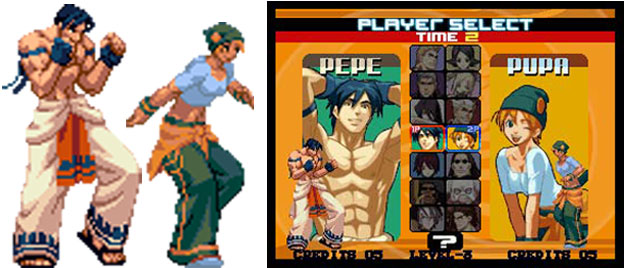
Rage of Dragons had capped a decade of Capoeira in the arcade and positive minorities in fighting games. The downside for people from other nations was that the roles were often fixed to the country of origin. Most karate experts were Japanese, most boxers were black Americans, most kung-fu artists were Chinese, most wrestlers were white Americans and most capoeiristas were Brazilian. However as Ron Van Clief,
Dennis Brown,
Willie Williams and other African-Americans had shown, the black community could excel at kung-fu, karate and wrestling in the home countries of the art. Foreigners had contributed greatly to the fighting arts from other nations. Asians could be great boxers, Europeans could be great at judo and anyone could practice capoeira. When a small team of developers got together to see if they could make an all-capoeira fighter they set a standard yet to be topped. The next blog will look at this series. As always if you enjoyed this blog and would like to sponsor me
please visit my Patreon page and consider donating each month, even as little as $1 would help make better blogs and even podcasts!









In addition, you can explore other new games like Play Find The Crypto Game Online. Unlock all levels and win with the highest score.
ReplyDelete